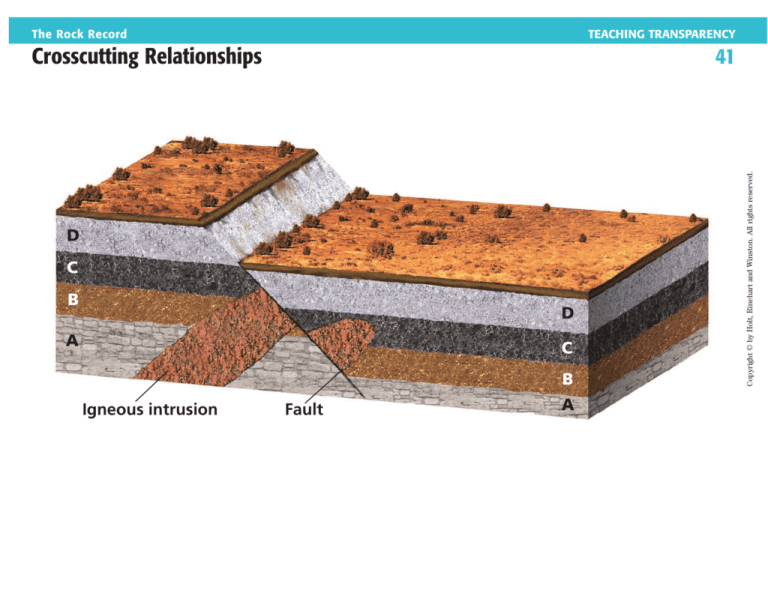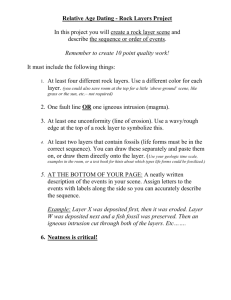
The Rock Record
TEACHING TRANSPARENCY
41
D
C
B
D
A
C
B
Igneous intrusion
Fault
A
Copyright © by Holt, Rinehart and Winston. All rights reserved.
Crosscutting Relationships
Name
Class
Date
Transparency Worksheet
Crosscutting Relationships
1. In the diagram, which rock is youngest, the fault or the igneous intrusion?
Explain your answer.
2. In this diagram, what event occurred most recently? Explain your answer.
3. Which is younger, the igneous intrusion or layer C? Explain your answer.
4. Can you tell which occurred first, the intrusion or the deposition of layer D?
Explain your answer.
Copyright © by Holt, Rinehart and Winston. All rights reserved.
Holt Earth Science
The Rock Record
ANSWER KEY
2. the turbine
3. a generator
4. Answers may vary. Sample answer: The
41 Crosscutting Relationships
1. the fault, because the law of crosscut-
ting relationships states that the fault is
younger than the rock it cuts
2. Faulting must have occurred most
recently because it cuts through all the
layers of rock and the intrusion.
3. The igneous intrusion is younger
because it cuts through layer C.
4. No. Either could have formed after
layer C was deposited but before faulting occurred.
turbine spins rapidly to generate electricity. Fish would have to pass through
it to get past the dam.
5. Answers may vary. Sample answer:
Yes, but a smaller amount of electricity
would be generated.
38 Wind Power in the United States
1.
2.
3.
4.
5.
6.
WY and AK
CA and WA
TX
the Rocky Mountains
TX
The comparison means that these
states could be a major source of wind
energy, much as Saudi Arabia is a
major source of oil.
42 Radioactive Decay and Half-Life
1. In beta decay, a neutron gives off a
2.
39 Law of Superposition
1. sedimentary rock
2. that the rock layer is underformed
3. Sedimentary layers will always be
deposited on top of metamorphic rock
or large igneous rock masses. Igneous
rock from volcanic eruptions can be
deposited as part of the rock sequence.
4. Layer B is older than layer C, because
the law of superposition dictates that
an underformed rock layer is older
than the layers above it.
3.
4.
5.
43 Geologic Map of Bedrock in Ohio
1. the Permian, Pennsylavanian,
2.
3.
40 Types of Unconformities
1. Nonconformities involve layers of
2.
3.
4.
5.
sedimentary rock that form on top of
unstratified rock. Angular unconformities and disconformities both involve
sedimentary rock layers that form on
top of stratified rock.
Unconformities indicate that a rock
layer was exposed to erosion for a
period of time before the overlying sedimentary layers were deposited. This
erosional period creates a break in the
geologic record.
metamorphic or igneous rock
a disconformity, because all of the rock
layers are stratified and horizontal
an angular unconformity
beta particle. In alpha decay, an alpha
particle consisting of two protons and
two neutrons is emitted.
The mass of the atom decreases
because the atom loses two protons
and two neutrons that make up the
alpha particle.
4
one-half
after one half-life
4.
5.
6.
Mississippian, devonian, Silurian, and
Ordovician
The youngest bedrock is in the southeastern part of the state; the oldest bedrock is in the western part of the state.
In traveling east to west, the bedrock
would generally become older.
The bedrock layers are tilted upwards.
The more horizontal surface of earth
cuts across the angled layers and thus
exposes them. If the layers were horizontal, only the top, or youngest layer
wuld be exposed.
because Mississippian rock was formed
in the Mississippian Period just after the
rock formed in the Devonian Period
To find early reptile fossils you’d look
in Pennsylvanian rock, represented by
the color blue, which occurs in a large
stripe extending to the southwest from
eastern Ohio.
44 The Geologic Time Scale
1. More recent rocks have been altered or
eroded less than older rocks have and
Copyright © by Holt, Rinehart and Winston. All rights reserved.
Holt Earth Science
12
Answer Key







